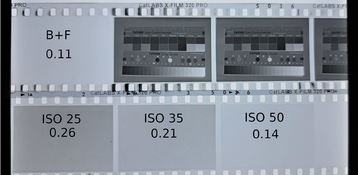aparat
Member
I haven't posted in a while. My health issues are flaring up again, so I can only work for brief moments here and there. I apologize for not responding to other people's posts over the past few days.
My son set up a "Fred Picker" film test for me the other day to see how the Catlabs Pro 320 would respond to a commonly used EI measuring technique among Zone System practitioners. The idea is very simple. I will describe it here so other forum members can try it for themselves. Photographers who do not do Zone System, can probably disregard this post. The procedure has quite a few more variables than my previous curve family test, so, by design, it cannot be as accurate. However, as a lot of Zone System photographers have found over the decades, it is capable of obtaining reasonable results, esp. for sheet film use.

I also exposed a Tiffen color chart metering for ISO 65 (as determined in my curve analysis) and exposed 3 frames. I did this mostly to do a crude, but somewhat effective (I believe) color response analysis. I metered for the grey card to get my exposure (background behid the color chart). The frame was then scanned in using Vuescan's default settings for generic black and white negative. The scanner is old and not meant for photography but that's the best I can do. I also did not control any of the default Vuescan settings, so please, take this with a grain of salt.

And here's the color picture of the chart for comparison. The spectral response obtained here seems to confirmed the findings from my very first test to some degree. I will abstain from speculating further, as I lack the necessary data to make any kind of conclusion. I still plan on doing a more thorough spectral response test, but it'll have to wait until my health improves a bit.

One last thing. Once again, I am getting no drying marks on either side of this film. I've processed at least four dozen strips Catlabs Pro 320 so far, and the base seems, for whatever reason, resistant to drying marks. I just use a couple of drops of Photo-flo in about 500 ml of tap water for the final rinse. No need for distilled water, which is a huge plus in my book. I don't know much about film base, but perhaps this polyester material somehow allows water to evaporate without leaving marks? Perhaps others could chime in and try to speculate why that might be the case.
My son set up a "Fred Picker" film test for me the other day to see how the Catlabs Pro 320 would respond to a commonly used EI measuring technique among Zone System practitioners. The idea is very simple. I will describe it here so other forum members can try it for themselves. Photographers who do not do Zone System, can probably disregard this post. The procedure has quite a few more variables than my previous curve family test, so, by design, it cannot be as accurate. However, as a lot of Zone System photographers have found over the decades, it is capable of obtaining reasonable results, esp. for sheet film use.
- Place a black card in shade (to simulate Zone I).
- Put camera on tripod.
- Focus on infinity.
- Fill the entire frame with the card.
- Set the spot meter to ¼ of manufacturer’s recommended speed (here ISO 25, based on my curve family test, in which I used an ISO 100 exposure) (f/2.8** at 1/15s, determined using a Minolta Spotmeter F).
- Close down 4 stops (with aperture and/or shutter speed), thus placing exposure on Zone I.
- Transfer reading to camera and expose.
- Close down and expose subsequent frames in ½ stop increments (I used a Minolta X-570, in good operating shape and a 50mm f/1.7 lens).

I also exposed a Tiffen color chart metering for ISO 65 (as determined in my curve analysis) and exposed 3 frames. I did this mostly to do a crude, but somewhat effective (I believe) color response analysis. I metered for the grey card to get my exposure (background behid the color chart). The frame was then scanned in using Vuescan's default settings for generic black and white negative. The scanner is old and not meant for photography but that's the best I can do. I also did not control any of the default Vuescan settings, so please, take this with a grain of salt.

And here's the color picture of the chart for comparison. The spectral response obtained here seems to confirmed the findings from my very first test to some degree. I will abstain from speculating further, as I lack the necessary data to make any kind of conclusion. I still plan on doing a more thorough spectral response test, but it'll have to wait until my health improves a bit.

One last thing. Once again, I am getting no drying marks on either side of this film. I've processed at least four dozen strips Catlabs Pro 320 so far, and the base seems, for whatever reason, resistant to drying marks. I just use a couple of drops of Photo-flo in about 500 ml of tap water for the final rinse. No need for distilled water, which is a huge plus in my book. I don't know much about film base, but perhaps this polyester material somehow allows water to evaporate without leaving marks? Perhaps others could chime in and try to speculate why that might be the case.
Last edited:









